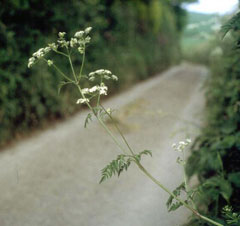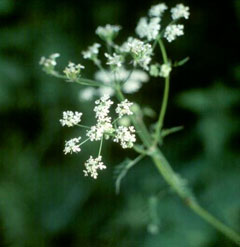 |
|
http://commons.wikimedia.org/wiki/File:Koeh-162.jpg |
 |
| (c) 2010 Ken Fern & Plants For A Future |
Translate this page:
Summary
A herbaceous biennial or short-lived perennial plant in the family Apiaceae and related to parsley, carrot, hemlock and hogweed. that can be confused with giant cow parsley (Heracleum mantegazzianum) or French cow parsley (Orlaya grandiflora). Some medicinal, edible and other uses although it does have an unpleasant flavour. Common names include cow parsley, wild chervil, wild beaked parsley, keck,or Queen Anne's lace.
Physical Characteristics

 Anthriscus sylvestris is a BIENNIAL growing to 1.2 m (4ft) by 0.6 m (2ft in).
Anthriscus sylvestris is a BIENNIAL growing to 1.2 m (4ft) by 0.6 m (2ft in).
See above for USDA hardiness. It is hardy to UK zone 7 and is not frost tender. It is in flower from April to June, and the seeds ripen from June to July. The species is hermaphrodite (has both male and female organs) and is pollinated by Bees. The plant is self-fertile.
Suitable for: light (sandy), medium (loamy) and heavy (clay) soils. Suitable pH: mildly acid, neutral and basic (mildly alkaline) soils. It can grow in full shade (deep woodland) semi-shade (light woodland) or no shade. It prefers dry or moist soil.
UK Hardiness Map
US Hardiness Map
Synonyms
Chaerophyllum sylvestre L.
Plant Habitats
Woodland Garden Dappled Shade; Shady Edge; Hedgerow;
Edible Uses
Edible Parts: Leaves Root
Edible Uses:
The leaves are eaten raw, cooked as a potherb or used as a flavouring[5, 12, 53, 183]. They taste somewhat less than wonderful[K]. Root - cooked[183].
References More on Edible Uses
Medicinal Uses
Plants For A Future can not take any responsibility for any adverse effects from the use of plants. Always seek advice from a professional before using a plant medicinally.
Tonic
The root is soaked for several days in rice washings and then cooked with other foods as a tonic for general weakness[218].
References More on Medicinal Uses
The Bookshop: Edible Plant Books
Our Latest books on Perennial Plants For Food Forests and Permaculture Gardens in paperback or digital formats.

Edible Tropical Plants
Food Forest Plants for Hotter Conditions: 250+ Plants For Tropical Food Forests & Permaculture Gardens.
More

Edible Temperate Plants
Plants for Your Food Forest: 500 Plants for Temperate Food Forests & Permaculture Gardens.
More

More Books
PFAF have eight books available in paperback and digital formats. Browse the shop for more information.
Shop Now
Other Uses
Dye
A beautiful green dye is obtained from the leaves and stem but it is not very permanent[115].
Special Uses
References More on Other Uses
Cultivation details
Succeeds in most soils. Shade tolerant[31]. The root has been recommended for improvement by selection and breeding as an edible crop[183]. This plant looks quite similar to some poisonous species, make sure that you identify it correctly.
References Carbon Farming Information and Carbon Sequestration Information
Temperature Converter
Type a value in the Celsius field to convert the value to Fahrenheit:
Fahrenheit:
The PFAF Bookshop
Plants For A Future have a number of books available in paperback and digital form. Book titles include Edible Plants, Edible Perennials, Edible Trees,Edible Shrubs, Woodland Gardening, and Temperate Food Forest Plants. Our new book is Food Forest Plants For Hotter Conditions (Tropical and Sub-Tropical).
Shop Now
Plant Propagation
Seed - sow as soon as ripe (June/July) in situ. The seed can also be sown April/May in situ. It usually germinates in 1 - 3 months at 20°c.
Other Names
If available other names are mentioned here
Native Plant Search
Search over 900 plants ideal for food forests and permaculture gardens. Filter to search native plants to your area. The plants selected are the plants in our book 'Plants For Your Food Forest: 500 Plants for Temperate Food Forests and Permaculture Gardens, as well as plants chosen for our forthcoming related books for Tropical/Hot Wet Climates and Mediterranean/Hot Dry Climates. Native Plant Search
Found In
Countries where the plant has been found are listed here if the information is available
Weed Potential
Right plant wrong place. We are currently updating this section.
Please note that a plant may be invasive in one area but may not in your area so it’s worth checking.
Noxious Weed: Massachusetts, US (wild chervil) Prohibited. Washington, US -Class B noxious weed. This plant can be weedy or invasive in other areas.
Conservation Status
IUCN Red List of Threatened Plants Status : This taxon has not yet been assessed.

Growth: S = slow M = medium F = fast. Soil: L = light (sandy) M = medium H = heavy (clay). pH: A = acid N = neutral B = basic (alkaline). Shade: F = full shade S = semi-shade N = no shade. Moisture: D = dry M = Moist We = wet Wa = water.

Expert comment
Author
(L.)Hoffm.
Botanical References
17200
Links / References
For a list of references used on this page please go here
Readers comment